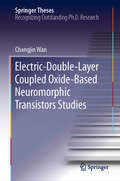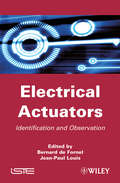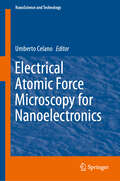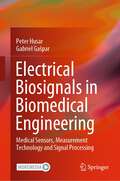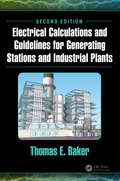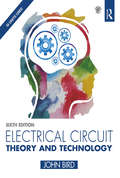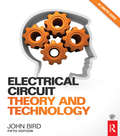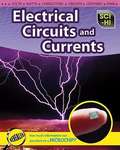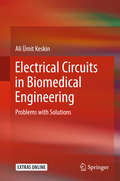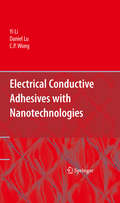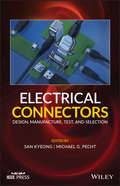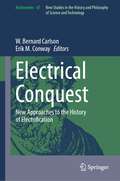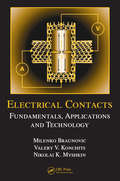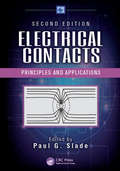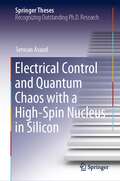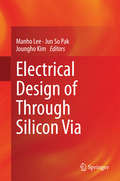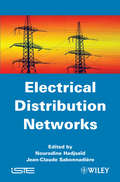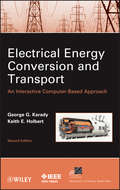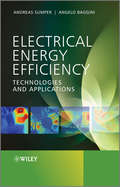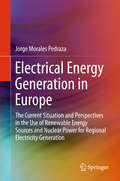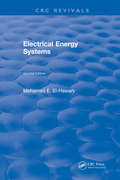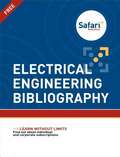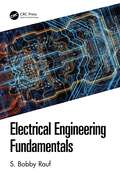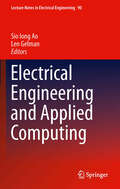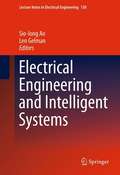- Table View
- List View
Electric-Double-Layer Coupled Oxide-Based Neuromorphic Transistors Studies (Springer Theses)
by Changjin WanThis book focuses on essential synaptic plasticity emulations and neuromorphic computing applications realized with the aid of three-terminal synaptic devices based on ion-coupled oxide-based electric-double-layer (EDL) transistors. To replicate the robust, plastic and fault-tolerant computational power of the human brain, the emulation of essential synaptic plasticity and computation of neurons/synapse by electronic devices are generally considered to be key steps. The book shows that the formation of an EDL at the dielectric/channel interface that slightly lags behind the stimuli can be attributed to the electrostatic coupling between ions and electrons; this mechanism underlies the emulation of short-term synaptic behaviors. Furthermore, it demonstrates that electrochemical doping/dedoping processes in the semiconducting channel by penetrated ions from electrolyte can be utilized for the emulation of long-term synaptic behaviors. Lastly, it applies these synaptic transistors in an artificial visual system to demonstrate the potential for constructing neuromorphic systems. Accordingly, the book offers a unique resource on understanding the brain-machine interface, brain-like chips, artificial cognitive systems, etc.
Electrical Actuators: Applications and Performance
by Jean-Paul Louis Bernard de FornelThis helpful resource covers a large range of information regarding electrical actuators. In particular, robustness, a very problematic issue, is fully explored in a dedicated chapter. The text also deals with he estimate of non-measurable mechanical variables by examining the estimate of load moment, then observation of the positioning of a command without mechanical sensor. Finally, it examines the conditions needed to measure variables and real implementation of numerical algorithms. This is a key working resource for electrical engineers.
Electrical Atomic Force Microscopy for Nanoelectronics (NanoScience and Technology)
by Umberto CelanoThe tremendous impact of electronic devices on our lives is the result of continuous improvements of the billions of nanoelectronic components inside integrated circuits (ICs). However, ultra-scaled semiconductor devices require nanometer control of the many parameters essential for their fabrication. Through the years, this created a strong alliance between microscopy techniques and IC manufacturing. This book reviews the latest progress in IC devices, with emphasis on the impact of electrical atomic force microscopy (AFM) techniques for their development. The operation principles of many techniques are introduced, and the associated metrology challenges described. Blending the expertise of industrial specialists and academic researchers, the chapters are dedicated to various AFM methods and their impact on the development of emerging nanoelectronic devices. The goal is to introduce the major electrical AFM methods, following the journey that has seen our lives changed by the advent of ubiquitous nanoelectronics devices, and has extended our capability to sense matter on a scale previously inaccessible.
Electrical Biosignals in Biomedical Engineering: Medical Sensors, Measurement Technology and Signal Processing
by Peter Husar Gabriel GašparDas grundlegende Kompendium führt in das zunehmend wichtiger werdende Thema der Biosginalverarbeitung ein. Der inhaltliche Aufbau orientiert sich an der Abfolge der diagnostischen Kette: von Sensorik, Signalverstärkung und -konditionierung über Signalabtastung und -digitalisierung, Methoden der Biosignalverarbeitung bis zu Auswertung und Diagnosevorschlag. Dabei liefert jedes Kapitel das entsprechende theoretische und methodische Wissen, behandelt Realisierungsalternativen und stellt Praxisbeispiele sowie die aktuell verfügbare Technik vor.
Electrical Calculations and Guidelines for Generating Stations and Industrial Plants
by Thomas E. BakerThe new edition aims to simplify the math, emphasize the theory, and consolidate the information needed by electrical engineers and technicians who support operations, maintenance, protective relay systems, and betterment projects for generating stations and industrial facilities. It begins with a cursory review of basic electrical phenomenon and then provides additional insights into electrical theory. Single phase and three phase electrical theory is explained in a simplified manner that is not presented in other books. All chapters have been expanded and updated, with the inclusion of an entirely new chapter.
Electrical Circuit Theory and Technology (6th Edition)
by John BirdA fully comprehensive text for courses in electrical principles, circuit theory and electrical technology, providing 800 worked examples and over 1,350 further problems for students to work through at their own pace. This book is ideal for students studying engineering for the first time as part of BTEC National and other pre-degree vocational courses, as well as Higher Nationals, Foundation Degrees and first-year undergraduate modules.
Electrical Circuit Theory and Technology, 5th ed
by John BirdThis much-loved textbook explains the principles of electrical circuit theory and technology so that students of electrical and mechanical engineering can master the subject. Real-world situations and engineering examples put the theory into context. The inclusion of worked problems with solutions help you to learn and further problems then allow you to test and confirm you have fully understood each subject. In total the book contains 800 worked problems, 1000 further problems and 14 revision tests with answers online. This an ideal text for foundation and undergraduate degree students and those on upper level vocational engineering courses, in particular electrical and mechanical. It provides a sound understanding of the knowledge required by technicians in fields such as electrical engineering, electronics and telecommunications. This edition has been updated with developments in key areas such as semiconductors, transistors, and fuel cells, along with brand new material on ABCD parameters and Fourier’s Analysis. It is supported by a companion website that contains solutions to the 1000 questions in the practice exercises, formulae to help students answer the questions and information about the famous mathematicians and scientists mentioned in the book. Lecturers also have access to full solutions and the marking scheme for the 14 revision tests, lesson plans and illustrations from the book.
Electrical Circuits and Currents
by Barbara A. SomervillWhat is St. Elmo's Fire? How does a steam turbine generate electricity? Which scientist developed the first battery? Electrical Circuits and Currents takes a look at how electricity works, and the forms that it takes. You will learn about electrical charges, series and parallel circuits, and materials that conduct electricity. You will even discover how to create your own schematic diagrams of electrical circuits! Wire it up and enter the always fascinating world of electrical circuits and currents! Sci-Hi is a visually stimulating series that takes learning science core curriculum to a whole new level! Each title in the series explores an area of life, physical, or earth science in a way that is both engaging and comprehensive. Topics include everything from chemical reactions to cell function and specialization. Features of the series include high-interest spreads, fantastic photos and artwork, science activities and projects, quizzes, reviews, timelines, and two or more pages of glossary words and further information. Book jacket.
Electrical Circuits in Biomedical Engineering
by Ali Ümit KeskinThis book presents a comprehensive and in-depth analysis of electrical circuit theory in biomedical engineering, ideally suited as textbook for a graduate course. It contains methods and theory, but the topical focus is placed on practical applications of circuit theory, including problems, solutions and case studies. The target audience comprises graduate students and researchers and experts in electrical engineering who intend to embark on biomedical applications.
Electrical Conductive Adhesives with Nanotechnologies
by C. P. Wong Daniel Lu Yi Grace Li"Electrical Conductive Adhesives with Nanotechnologies" begins with an overview of electronic packaging and discusses the various adhesives options currently available, including lead-free solder and ECAs (Electrically Conductive Adhesives). The material presented focuses on the three ECA categories specifically, Isotropically Conductive Adhesives (ICAs) Anisotropically Conductive Adhesives/Films (ACA/ACF) and Nonconductive Adhesives/Films (NCA/NCF). Discussing the advantages and limitations of each technique, and how each technique is currently applied. Lastly, a detailed presentation of how nano techniques can be applied to conductive adhesives is discussed, including recent research and development of nano component adhesives/nano component films, their electrical properties, thermal performance, bonding pressure and assembly and reliability.
Electrical Connectors: Design, Manufacture, Test, and Selection (Wiley - IEEE)
by Michael G. Pecht San KyeongDiscover the foundations and nuances of electrical connectors in this comprehensive and insightful resource Electrical Connectors: Design, Manufacture, Test, and Selection delivers a comprehensive discussion of electrical connectors, from the components and materials that comprise them to their classifications and underwater, power, and high-speed signal applications. Accomplished engineer and author Michael G. Pecht offers readers a thorough explanation of the key performance and reliability concerns and trade-offs involved in electrical connector selection. Readers, both at introductory and advanced levels, will discover the latest industry standards for performance, reliability, and safety assurance. The book discusses everything a student or practicing engineer might require to design, manufacture, or select a connector for any targeted application. The science of contact physics, contact finishes, housing materials, and the full connector assembly process are all discussed at length, as are test methods, performance, and guidelines for various applications. Electrical Connectors covers a wide variety of other relevant and current topics, like: A comprehensive description of all electrical connectors, including their materials, components, applications, and classifications A discussion of the design and manufacture of all parts of a connector Application-specific criteria for contact resistance, signal quality, and temperature rise An examination of key suppliers, materials used, and the different types of data provided A presentation of guidelines for end-users involved in connector selection and design Perfect for connector manufacturers who select, design, and assemble connectors for their products or the end users who concern themselves with operational reliability of the system in which they’re installed, Electrical Connectors also belongs on the bookshelves of students learning the basics of electrical contacts and those who seek a general reference with best-practice advice on how to choose and test connectors for targeted applications.
Electrical Conquest: New Approaches to the History of Electrification (Archimedes #67)
by W. Bernard Carlson Erik M. ConwayThis book, drawing on fresh scholarship, investigates electrification in new places and across different time periods. While much of our understanding of electrification as a historical process is based on the seminal work done by Thomas P. Hughes in Networks of Power (1983), the scholars in this volume expand and revise Hughes’ systems approach to suggest that electrification is a heterogeneous and contingent process. Moreover, the contributors suggest that the conquest of the world by electricity remains incomplete despite more than a century elapsing. Above all, though, this book provides context for thinking about what lies ahead as humans continue their conquest of the earth through electricity. As we become increasingly dependent on electricity to power our lights, heat and cool our homes, turn the wheels of industry, and keep our information systems humming, so we are ever more vulnerable when the grid runs into trouble.Chapter "Surveying the Landscape: The Oil Industry and Alternative Energy in the 1970s" is available open access under a Creative Commons Attribution 4.0 International License via link.springer.com.
Electrical Contacts: Fundamentals, Applications and Technology (Electrical and Computer Engineering)
by Nikolai K. Myshkin Milenko Braunovic Valery V. KonchitsVarious factors affect the performance of electrical contacts, including tribological, mechanical, electrical, and materials aspects. Although these behaviors have been studied for many years, they are not widely used or understood in practice. Combining approaches used across the globe, Electrical Contacts: Fundamentals, Applications, and Technology integrates advances in research and development in the tribological, material, and analytical aspects of electrical contacts with new data on electrical current transfer at the micro- and nanoscales.Taking an application-oriented approach, the authors illustrate how material characteristics, tribological behavior, and loading impact the degradation of contacts, formation of intermetallics, and overall reliability and performance. Coverage is divided broadly into three sections, with the first focused on mechanics, tribology, materials, current and heat transfer, and basic reliability issues of electrical contacts. The next section explores applications, such as power connections, electronic connections, and sliding contacts, while the final section presents the diagnostic and monitoring techniques used to investigate and measure phenomena occurring at electrical contact interfaces. Numerous references to current literature reflect the fact that this book is the most comprehensive survey in the field.Explore an impressive collection of data, theory, and practical applications in Electrical Contacts: Fundamentals, Applications, and Technology, a critical tool for anyone investigating or designing electrical equipment with improved performance and reliability in mind.
Electrical Contacts: Principles and Applications, Second Edition
by Paul G. SladeCovering the theory, application, and testing of contact materials, Electrical Contacts: Principles and Applications, Second Edition introduces a thorough discussion on making electric contact and contact interface conduction; presents a general outline of, and measurement techniques for, important corrosion mechanisms; considers the results of contact wear when plug-in connections are made and broken; investigates the effect of thin noble metal plating on electronic connections; and relates crucial considerations for making high- and low-power contact joints. It examines contact use in switching devices, including the interruption of AC and DC circuits with currents in the range 10mA to 100kA and circuits up to 1000V, and describes arc formation between open contacts and between opening contacts. Arcing effects on contacts such as erosion, welding, and contamination are also addressed. Containing nearly 3,000 references, tables, equations, figures, drawings, and photographs, the book provides practical examples encompassing everything from electronic circuits to high power circuits, or microamperes to mega amperes. The new edition: Reflects the latest advances in electrical contact science and technology Examines current research on contact corrosion, materials, and switching Includes updates and revisions in each chapter, as well as up-to-date references and new figures and examples throughout Delivers three new chapters on the effects of dust contamination, electronic sensing for switching systems, and contact phenomena for micro-electronic systems (MEMS) applications With contributions from recognized experts in the field, Electrical Contacts: Principles and Applications, Second Edition assists practicing scientists and engineers in the prevention of costly system failures, as well as offers a comprehensive introduction to the subject for technology graduate students, by expanding their knowledge of electrical contact phenomena.
Electrical Control and Quantum Chaos with a High-Spin Nucleus in Silicon (Springer Theses)
by Serwan AsaadNuclear spins are highly coherent quantum objects that were featured in early ideas and demonstrations of quantum information processing. In silicon, the high-fidelity coherent control of a single phosphorus (31-P) nuclear spin I=1/2 has demonstrated record-breaking coherence times, entanglement, and weak measurements. In this thesis, we demonstrate the coherent quantum control of a single antimony (123-Sb) donor atom, whose higher nuclear spin I = 7/2 corresponds to eight nuclear spin states. However, rather than conventional nuclear magnetic resonance (NMR), we employ nuclear electric resonance (NER) to drive nuclear spin transitions using localized electric fields produced within a silicon nanoelectronic device. This method exploits an idea first proposed in 1961 but never realized experimentally with a single nucleus, nor in a non-polar crystal such as silicon. We then present a realistic proposal to construct a chaotic driven top from the nuclear spin of 123-Sb. Signatures of chaos are expected to arise for experimentally realizable parameters of the system, allowing the study of the relation between quantum decoherence and classical chaos, and the observation of dynamical tunneling. These results show that high-spin quadrupolar nuclei could be deployed as chaotic models, strain sensors, hybrid spin-mechanical quantum systems, and quantum-computing elements using all-electrical controls.
Electrical Design of Through Silicon Via
by Manho Lee Jun So Pak Joungho KimThrough Silicon Via (TSV) is a key technology for realizing three-dimensional integrated circuits (3D ICs) for future high-performance and low-power systems with small form factors. This book covers both qualitative and quantitative approaches to give insights of modeling TSV in a various viewpoints such as signal integrity, power integrity and thermal integrity. Most of the analysis in this book includes simulations, numerical modelings and measurements for verification. The author and co-authors in each chapter have studied deep into TSV for many years and the accumulated technical know-hows and tips for related subjects are comprehensively covered.
Electrical Distribution Networks
by Jean-Claude Sabonnadière Nouredine HadjsaïdThis book describes the fundamental aspects of the new generation of electrical distribution grids, taking as its starting point the opportunities that exist for restructuring existing infrastructure. It emphasizes the incorporation of renewable energy sources into the distribution grid and the need for a technological evolution towards the implementation of smartgrids. The book is organized into two parts: the first part analyzes the integration of distributed energy sources into the distribution grid and the impact of these sources on grid operation. After a general description of the general characteristics of distribution grids and renewable energy sources, it then analyzes the economics of electrical energy distribution networks and presents the impact of these sources on grid operation. The second part of the book then analyzes the various functions which allow for safe operation of the grid and realization of the path towards real world application of smartgrids.
Electrical Energy Conversion and Transport
by Keith E. Holbert George G. KaradyProvides relevant material for engineering students and practicing engineers who want to learn the basics of electrical power transmission, generation, and usage This Second Edition of Electrical Energy Conversion and Transport is thoroughly updated to address the recent environmental effects of electric power generation and transmission, which have become more important in conjunction with the deregulation of the industry. The maintenance and development of the electrical energy generation and transport industry requires well-trained engineers who are able to use modern computation techniques to analyze electrical systems and understand the theory of electrical energy conversion. It includes new content that explores different power production methods, such as renewable energy sources (solar, wind, geothermal and ocean), as well as new sections that discuss the upcoming Smart Grid and distributed power generation using renewable energy conversion. Complete with a Solutions Manual and the use of Mathcad, MATLAB, and PSpice throughout for problem solving, Electrical Energy Conversion and Transport offers chapter coverage of: Electric Power Systems Single-Phase Circuits Transmission Lines Transformers Induction Machines Introduction to Power Electronics and Motor Control Electric Generating Stations Three-Phase Circuits Electromechanical Energy Conversion Synchronous Machines DC Machines This book is essential reading material for students and practicing engineers in the power industry who would like to learn computer-based electrical energy conversion and transport at their own pace.
Electrical Energy Efficiency
by Andreas Sumper Angelo BagginiThe improvement of electrical energy efficiency is fast becoming one of the most essential areas of sustainability development, backed by political initiatives to control and reduce energy demand.Now a major topic in industry and the electrical engineering research community, engineers have started to focus on analysis, diagnosis and possible solutions. Owing to the complexity and cross-disciplinary nature of electrical energy efficiency issues, the optimal solution is often multi-faceted with a critical solutions evaluation component to ensure cost effectiveness.This single-source reference brings a practical focus to the subject of electrical energy efficiency, providing detailed theory and practical applications to enable engineers to find solutions for electroefficiency problems. It presents power supplier as well as electricity user perspectives and promotes routine implementation of good engineering practice.Key features include:a comprehensive overview of the different technologies involved in electroefficiency, outlining monitoring and control concepts and practical design techniques used in industrial applications;description of the current standards of electrical motors, with illustrative case studies showing how to achieve better design;up-to-date information on standarization, technologies, economic realities and energy efficiency indicators (the main types and international results);coverage on the quality and efficiency of distribution systems (the impact on distribution systems and loads, and the calculation of power losses in distribution lines and in power transformers).With invaluable practical advice, this book is suited to practicing electrical engineers, design engineers, installation designers, M&E designers, and economic engineers. It equips maintenance and energy managers, planners, and infrastructure managers with the necessary knowledge to properly evaluate the wealth of electrical energy efficiency solutions for large investments. This reference also provides interesting reading material for energy researchers, policy makers, consultants, postgraduate engineering students and final year undergraduate engineering students.
Electrical Energy Generation in Europe
by Jorge Morales PedrazaMaximizing reader insights into the current use of conventional energy sources (such as fossil fuels) in the generation of electricity in the European region, this book addresses several key issues including: potential ways European countries could expand their energy sector in the coming years; the impact on the climate, the level of energy reserves, different efficiency measures that could be adopted to reduce the consumption of fossil fuels in the generation of electricity, and current and future energy production and consumption trends, amongst other topics. Covering both how the use of fossil fuels for the generation of electricity can be reduced, and how to increase the current level of participation of those energy sources with a minimum negative impact on the environment in the energy balance of the different European countries, this book describes the main economic aspects related to the use of conventional energy sources for electricity generation and provides information on possible regional energy integration mechanisms and their potential impact on the generation of electricity. 'Electrical Energy Generation in Europe' is designed as a useful tool for government officials, energy experts, and the private and public power industry, among others, during the preparation of future energy plans and in the identification of the possible role that the different types of conventional energy sources available in the region could play in the production of electricity during the coming decades. The book is also suitable for use as teaching material in pre-graduated and post-graduate studies on the use of different types of conventional energy sources for electricity production within different European countries.
Electrical Energy Systems: Second Edition
by Mohamed E. El-HawaryWe are witness to the emergence a new generation of power engineers, focused on providing electric energy in a deregulated environment. To educate this new breed, textbooks must take a comprehensive approach to electrical energy and encourage problem solving using modern tools. Updated to reflect recent trends and new areas of emphasis, Mohamed El-Hawary's Electrical Energy Systems, Second Edition shifts the teaching of electrical energy and electric power toward a sustainable and reliable paradigm.Discussions ranging from the technical aspects of generation, transmission, distribution, and utilization to power system components, theory, protection, and the energy control center culminate in the most modern and complete introduction to effects of deregulating electric power systems, blackouts and their causes, and minimizing their effects. The author prepares students for real-world challenges by including numerous examples, problems, and MATLAB scripts, teaching students to use industry-standard problem-solving tools. This edition also features an entirely new chapter on the present and future of electric energy systems, which highlights new challenges facing system designers and operators in light of modern events and transformations impacting the field. Providing convenience for instructors in addition to a thoroughly modern education for students, Electrical Energy Systems, Second Edition sets a new benchmark for the education of electric power engineering focused on sustainable development and operation of new power systems.
Electrical Engineering Bibliography
by Safari Content TeamElectrical engineering, simply stated, is the study and application of electricity and its circuits. Electrical engineers focus on designing, implementing and improving products powered by electricity. Within this field, some electrical engineers focus on one product such as a generator or maybe the specific components in a communication system. It is the engineer's responsibility most often to then design and test new devices in one of these particular fields. Use this bibliography to access the excellent resources on all of the fields of Electrical Engineering that are available in the Safari Books Online library. Whether you want to focus on one particular area of electrical engineering, or if you want to survey everything, this bibliography has everything you need in learning more about this exciting science-based career.
Electrical Engineering Fundamentals
by S. Bobby RaufMany, in their quest for knowledge in engineering, find typical textbooks intimidating. Perhaps due to an extensive amount of physics theory, an overwhelming barrage of math, and not enough practical application of the engineering principles, laws, and equations. Therein lies the difference between this text and those voluminous and daunting conventional university engineering textbooks. This text leads the reader into more complex and abstract content after explaining the electrical engineering concepts and principles in an easy to understand fashion, supported by analogies borrowed from day-to-day examples and other engineering disciplines. Many complex electrical engineering concepts, for example, power factor, are examined from multiple perspectives, aided by diagrams, illustrations, and examples that the reader can easily relate to. Throughout this book, the reader will gain a clear and strong grasp of electrical engineering fundamentals, and a better understanding of electrical engineering terms, concepts, principles, laws, analytical techniques, solution strategies, and computational techniques. The reader will also develop the ability to communicate with professional electrical engineers, controls engineers, and electricians on their "wavelength" with greater confidence. Study of this book can help develop skills and preparation necessary for succeeding in the electrical engineering portion of various certification and licensure exams, including Fundamentals of Engineering (FE), Professional Engineering (PE), Certified Energy Manager (CEM), and many other trade certification tests. This text can serve as a compact and simplified electrical engineering desk reference. This book provides a brief introduction to the NEC®, the Arc-Flash Code, and a better understanding of electrical energy and associated cost. If you need to gain a better understanding of myriad battery alternatives available in the market, their strengths and weaknesses, and how batteries compare with capacitors as energy storage devices, this book can be a starting point. This book is ideal for engineers, engineering students, facility managers, engineering managers, program/project managers, and other executives who do not possess a current working knowledge of electrical engineering. Because of the simple explanations, analogies, and practical examples employed by the author, this book serves as an excellent learning tool for non-engineers, technical writers, attorneys, electrical sales professionals, energy professionals, electrical equipment procurement agents, construction managers, facility managers, and maintenance managers.
Electrical Engineering and Applied Computing
by Sio-Iong Ao Len GelmanA large international conference in Electrical Engineering and Applied Computing was just held in London, 30 June - 2 July, 2010. This volume will contain revised and extended research articles written by prominent researchers participating in the conference. Topics covered include Control Engineering, Network Management, Wireless Networks, Biotechnology, Signal Processing, Computational Intelligence, Data Mining, Computational Statistics, Internet Computing, High Performance Computing, and industrial applications. The book will offer the states of arts of tremendous advances in electrical engineering and applied computing and also serve as an excellent reference work for researchers and graduate students working on electrical engineering and applied computing
Electrical Engineering and Intelligent Systems
by Sio-Iong Ao Len GelmanThe revised and extended papers collected in this volume represent the cutting-edge of research at the nexus of electrical engineering and intelligent systems. They were selected from well over 1000 papers submitted to the high-profile international World Congress on Engineering held in London in July 2011. The chapters cover material across the full spectrum of work in the field, including computational intelligence, control engineering, network management, and wireless networks. Readers will also find substantive papers on signal processing, Internet computing, high performance computing, and industrial applications. The Electrical Engineering and Intelligent Systems conference, as part of the 2011 World Congress on Engineering was organized under the auspices of the non-profit International Association of Engineers (IAENG). With more than 30 nations represented on the conference committees alone, the Congress features the best and brightest scientific minds from a multitude of disciplines related to engineering. These peer-reviewed papers demonstrate the huge strides currently being taken in this rapidly developing field and reflect the excitement of those at the frontiers of this research.
